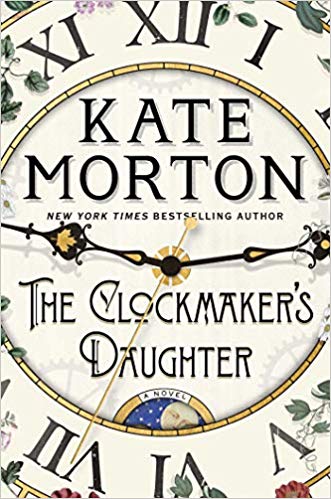The Clockmaker’s Daughter: A Novel
- By Kate Morton
- Atria Books
- 512 pp.
- Reviewed by Sara Dahmen
- October 12, 2018
Historical fiction blends with romance and the supernatural to create a compelling tale.

In the mid-1800s, talented, budding painter Edward Radcliffe takes a fancy to Lily Millington, a young woman far below his station. Their artistic collaboration and subsequent love, set against the backdrop of a house with a long memory, heady power, and deep secrets, creates a drama of ripples extending into 2017.
The murder of Radcliffe’s fiancée throws his entire world into chaos, especially when Millington and the Radcliffe family’s heirloom jewel disappear in the same night. Throughout the following years, the stories whispered about the house and the tragedies within it are juxtaposed with the comfort many find within the house’s walls over the ensuing centuries.
Each person who spends time in Birchwood Manor becomes part of the story woven into the fabric of the mystery and offers the reader explanations of previously alluded to characters or scenes. Their narratives touch one another, sometimes without anyone but the reader understanding the connection.
Elodie, the catalyst who slowly and unwittingly brings all the facts together, is a timid sort of creature. Her nature allows the reader to do the sleuthing, lending an interactive experience to the novel. As the reader discovers, the missing Millington, the lost blue diamond, and the secretive deaths and losses wrap together in an enigma spanning both World Wars, intersecting family stories and creating multilayered answers.
The titular clockmaker’s daughter, Millington herself, is the main protagonist in the novel, though we don’t understand her significance until the book races to its close. Like Leslie Parry’s Church of Marvels, The Clockmaker’s Daughter offers readers the opportunity to piece together the story in such a way that they will reel for days afterward, shocked at the conclusion but understanding exactly how everyone fits together like a perfectly designed jigsaw puzzle.
The mysteries’ finales feel like deep, emotional breaths of relief, contrasted with the less-than-tidy ending, which still matches the context and mood of the overall novel. It is realistic, if not tied in a pretty bow. I found it very satisfying.
I rarely discover books worth quoting or memorizing. Such writing typically has strong visual and visceral pulls, and the world within the pages must be so tantalizing and tactile that it sits in a person’s bones for a long time. The Clockmaker’s Daughter is just such a book, unfolding each hidden veil in a delicious, well-choreographed dance.
An historical-fiction novel with paranormal leanings, the book has several points of view, each providing the reader with characters who have incredibly varied voices and personalities. We hear from a war veteran, a retired policeman, an archivist, a writer, and an aristocratic girl, among others. Author Kate Morton creates mystical landscapes and secretive hints, combining the senses in unusual ways.
With “purple sounds,” moonlight that “spills silver,” and the vision of Radcliffe’s sister Lucy “sitting in the dark, secreted within a hidden cavity beneath the skin of Edward’s house” ringing through my mind, I was equally enthralled and deliciously unnerved by the ethereal and supernatural elements so carefully drawn as to feel nearly plausible.
And though I know that there isn’t really a house at a crossroads in the countryside of England where the Fairy Queen’s children lived and where beings of the underworld come up and haunt wayward wanderers, I almost wish there were.
If there is any complaint, it is only that the novel sometimes leans heavily on narrative, and whole chunks of chapters pass without a single word of dialogue. This can feel like telling rather than showing and occasionally turns into rather verbose backstory.
Still, these descriptive paragraphs are prettily written and move along well. Millington speaks in first person, present tense — a technique employed seamlessly — whereas the rest of the characters offer their tragedies in the past. All of this helps keep the multiple characters and points of view straight, as there is quite a robust cast.
I found the fairy-like paranormal aspects of the novel completely believable when wedged inside the realistic depictions of women and men ensconced within varying time periods. It feels entirely true that there might be ghosts, that the spirit world interacts with our own, and that artists such as Radcliffe painted celebrated art, creating a Magenta Brotherhood during the 1800s (I had to Google to see whether that detail was true!) where light, science, and art combined with intoxicating potential.
Morton has often given us novels touching on elements of the impossible, and The Clockmaker’s Daughter is yet another gift of lovely words and deep storylines. It is a worthwhile read, offering details, historic fact, mysticism, and lyrical execution that one can happily devour during the cozy Halloween season — or with a spirited book club able to dissect all the clues and twists and argue over who was first to figure out the mysteries locked within the pages.
Sara Dahmen is a tin and coppersmith who manufactures pure metal kitchenware in her Wisconsin garage. She has published more than 100 articles internationally, is the author of several historical-fiction novels, and spoke at TEDx Rapid City. When not sewing authentic clothing for 1830s reenactments, Sara can be found reading the Economist or spending time with her husband and three young children.

